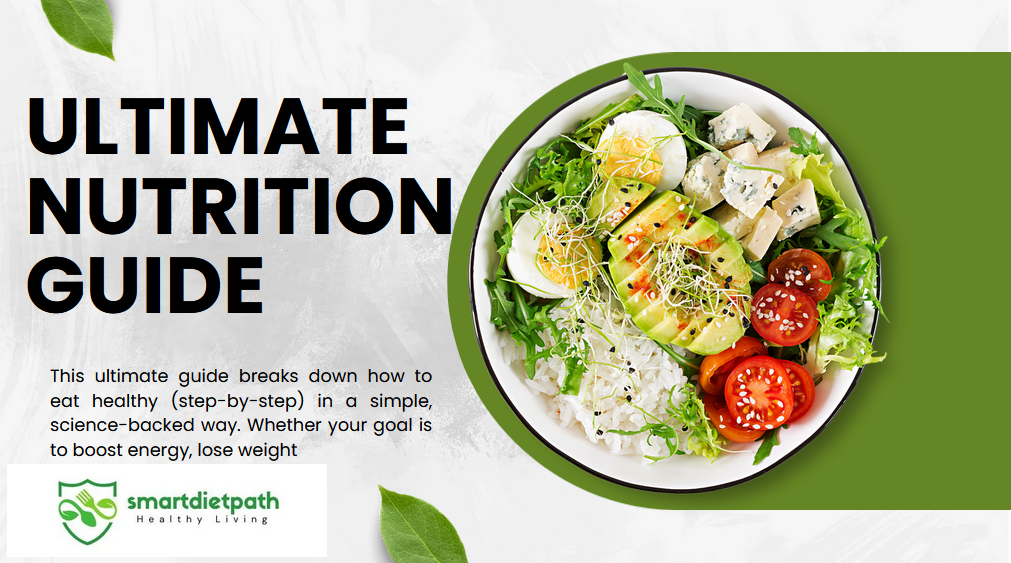Introduction: Why Eating Healthy Matters

Eating healthy doesn’t have to be complicated—yet for beginners, it can feel overwhelming. With so much conflicting advice online, where do you start? This ultimate guide breaks down how to eat healthy (step-by-step) in a simple, science-backed way. Whether your goal is to boost energy, lose weight, or just feel better, mastering the basics of nutrition is the first step.
In this guide, you’ll learn:
- The fundamentals of a balanced diet (no restrictive fads!).
- Easy meal-planning strategies for busy lifestyles.
- Common pitfalls to avoid as a beginner.
By the end, you’ll have a clear roadmap to make healthy eating sustainable and enjoyable. Let’s dive in!
What Does “Eating Healthy” Really Mean?
The Basics of a Balanced Diet
A healthy diet includes:
- Whole foods: Fruits, vegetables, lean proteins, whole grains, and healthy fats.
- Minimally processed foods: Limit added sugars, refined grains, and artificial ingredients.
- Hydration: Drink water as your primary beverage.
Pro Tip: Think of your plate as a canvas:
- 50% colorful veggies/fruits
- 25% lean protein (chicken, beans, tofu)
- 25% whole grains (quinoa, brown rice)
- A thumb-sized portion of healthy fats (avocado, nuts)
Secondary Keyword: “Balanced Diet for Beginners”
A balanced diet for beginners focuses on variety, not perfection. Start by adding one new healthy habit at a time—like swapping soda for sparkling water or adding veggies to every meal.
Step-by-Step Guide to Healthy Eating
Step 1: Set Realistic Goals
- SMART goals work best: Specific, Measurable, Achievable, Relevant, Time-bound.
- Example: “I’ll eat 2 servings of vegetables daily for 1 month.”
Step 2: Plan Your Meals (Like a Pro)
Use this simple meal-planning template:
| Meal | Healthy Options |
|---|---|
| Breakfast | Greek yogurt + berries + granola |
| Lunch | Grilled chicken salad with olive oil |
| Dinner | Baked salmon + quinoa + roasted veggies |
| Snacks | Apple slices + almond butter |
Secondary Keyword: “Easy Meal Prep for Beginners”
Batch-cook staples (e.g., grains, proteins) on Sundays to save time.
Step 3: Shop Smart
- Stick to the perimeter of the grocery store (where fresh foods live).
- Read labels: Avoid products with >5g added sugar per serving.
Common Mistakes to Avoid
- Over-restricting: Deprivation often backfires. Allow treats in moderation.
- Ignoring portion sizes: Use your hand as a guide (e.g., palm = protein portion).
- Skipping meals: Leads to overeating later.
FAQ: Your Nutrition Questions Answered
1. How can I eat healthy on a budget?
Focus on affordable staples like oats, eggs, frozen veggies, and beans.
2. Do I need to count calories?
Not necessarily. Prioritize food quality first—nutrient-dense foods naturally regulate hunger.
3. What’s the easiest way to cut sugar?
Swap sugary drinks for infused water or herbal tea.
Conclusion: Start Small, Win Big
You don’t need a drastic overhaul to eat healthy (step-by-step). Begin with one change this week—maybe adding a vegetable to dinner or drinking an extra glass of water. Celebrate small wins, and soon, healthy eating will become second nature.
Your turn: Pick one tip from this guide and try it today! Share your progress in the comments.
SEO Optimization Notes:
- Main keyword: “Eat Healthy (Step-by-Step), Ultimate guide, for beginners” (used 4x).
- Secondary keywords: “Balanced diet for beginners,” “Easy meal prep for beginners.”
- Readability: Short paragraphs, bullet points, and a friendly tone.
- Engagement: Includes a table, actionable steps, and a call-to-action.

